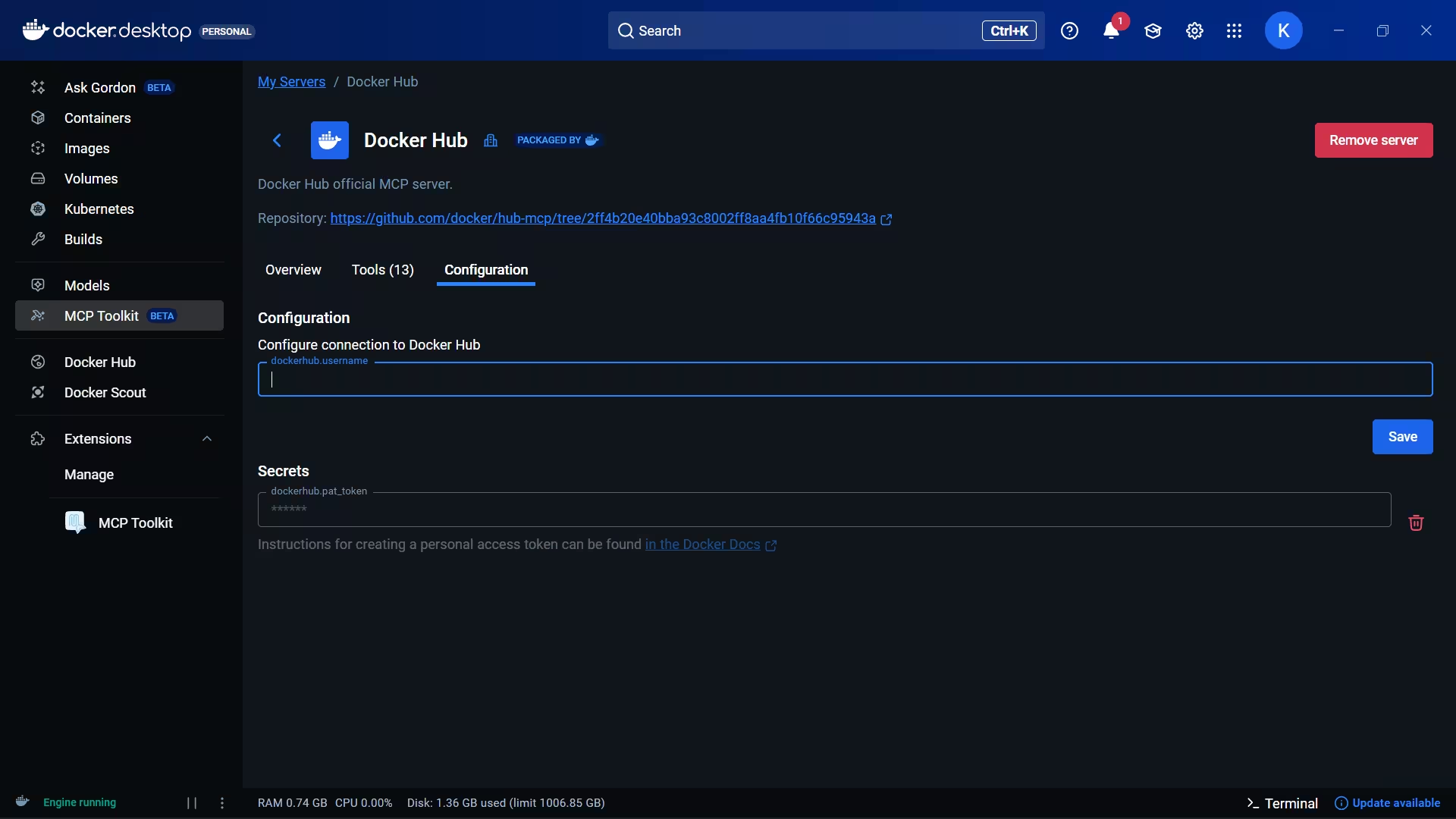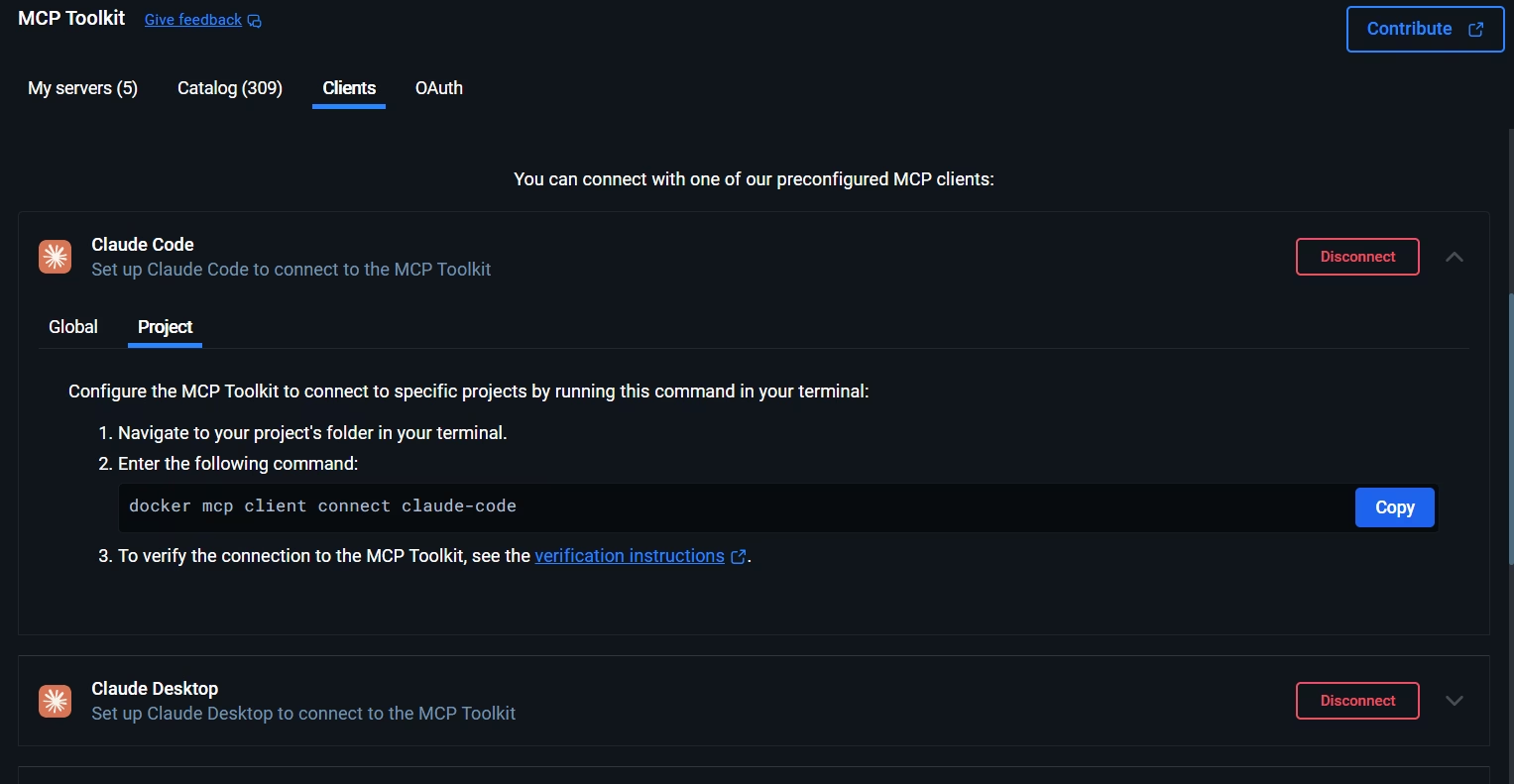Generate Docker Compose Files with Claude Code and Docker MCP Toolkit
This guide introduces how to use Claude Code together with Docker MCP Toolkit so Claude can search Docker Hub in real time and generate a complete docker-compose.yaml from natural language.
Instead of manually writing YAML or looking for image tags, you describe your stack once — Claude uses the Model Context Protocol (MCP) to query Docker Hub and build a production-ready Compose file.
In this guide, you’ll learn how to:
- Enable Docker MCP Toolkit in Docker Desktop
- Add the Docker Hub MCP server
- Connect Claude Code to the MCP Gateway (GUI or CLI)
- Verify MCP connectivity inside Claude
- Ask Claude to generate and save a Compose file for a Node.js + PostgreSQL app
- Deploy it instantly with
docker compose up
Use Claude Code and Docker MCP Toolkit to generate a Docker Compose file from natural language
- Setup: Enable MCP Toolkit → Add Docker Hub MCP server → Connect Claude Code
- Use Claude: Describe your stack in plain English
- Automate: Claude queries Docker Hub via MCP and builds a complete
docker-compose.yaml - Deploy: Run
docker compose up→ Node.js + PostgreSQL live onlocalhost:3000 - Benefit: Zero YAML authoring. Zero image searching. Describe once → Claude builds it.
Estimated time: ~15 minutes
1. What you are building
The goal is simple: use Claude Code together with the Docker MCP Toolkit to search Docker Hub images and generate a complete Docker Compose file for a Node.js and PostgreSQL setup.
The Model Context Protocol (MCP) bridges Claude Code and Docker Desktop, giving Claude real-time access to Docker's tools. Instead of context-switching between Docker, terminal commands, and YAML editors, you describe your requirements once and Claude handles the infrastructure details.
Why this matters: This pattern scales to complex multi-service setups, database migrations, networking, security policies — all through conversational prompts.
2. Prerequisites
Make sure you have:
Docker Desktop installed
Enable Docker Desktop updated with MCP Toolkit support
Claude Code installed
3. Install the Docker Hub MCP server
- Open Docker Desktop
- Select MCP Toolkit
- Go to the Catalog tab
- Search for Docker Hub
- Select the Docker HubMCP server
- Add the MCP server, then open the Configuration tab
- Enter your Docker Hub username
- Create a read-only personal access token and enter your access token under Secrets
- Save the configuration


Public images work without credentials. For private repositories, you can add your Docker Hub username and token later.


4. Connect Claude Code to Docker MCP Toolkit
You can connect from Docker Desktop or using the CLI.
Option A. Connect with Docker Desktop
- Open MCP Toolkit
- Go to the Clients tab
- Locate Claude Code
- Select Connect


Option B. Connect using the CLI
$ claude mcp add MCP_DOCKER -s user -- docker mcp gateway run
5. Verify MCP servers inside Claude Code
- Navigate to your project folder:
$ cd /path/to/project
- Start Claude Code:
$ claude
- In the input box, type:
/mcp
You should now see:
- The MCP gateway (for example
MCP_DOCKER) - Tools provided by the Docker Hub MCP server


If not, restart Claude Code or check Docker Desktop to confirm the connection.
6. Create a basic Node.js app
Claude Code generates more accurate Compose files when it can inspect a real project. Set up the application code now so the agent can bind mount it later.
Inside project folder, create a folder named app:
$ mkdir app
$ cd app
$ npm init -y
$ npm install express
Create index.js:
const express = require("express");
const app = express();
app.get("/", (req, res) => {
res.send("Node.js, Docker, and MCP Toolkit are working together!");
});
app.listen(3000, () => {
console.log("Server running on port 3000");
});
Add a start script to package.json:
"scripts": {
"start": "node index.js"
}
Return to your project root (cd ..) once the app is ready.
7. Ask Claude Code to design your Docker Compose stack
Paste this message into Claude Code:
Using the Docker Hub MCP server:
Search Docker Hub for an official Node.js image and a PostgreSQL image.
Choose stable, commonly used tags such as the Node LTS version and a recent major Postgres version.
Generate a Docker Compose file (`docker-compose.yaml`) with:
- app:
- runs on port 3000
- bind mounts the existing ./app directory into /usr/src/app
- sets /usr/src/app as the working directory and runs `npm install && npm start`
- db: running on port 5432 using a named volume
Include:
- Environment variables for Postgres
- A shared bridge network
- Healthchecks where appropriate
- Pin the image version using the tag + index digest
Claude will search images through MCP, inspect the app directory, and generate a Compose file that mounts and runs your local code.
8. Save the generated Docker Compose file
Tell Claude:
Save the final Docker Compose file (docker-compose.yaml) into the current project directory.
You should see something like this:
services:
app:
image: node:<tag>
working_dir: /usr/src/app
volumes:
- .:/usr/src/app
ports:
- "3000:3000"
depends_on:
- db
networks:
- app-net
db:
image: postgres:18
environment:
POSTGRES_USER: example
POSTGRES_PASSWORD: example
POSTGRES_DB: appdb
volumes:
- db-data:/var/lib/postgresql
ports:
- "5432:5432"
networks:
- app-net
volumes:
db-data:
networks:
app-net:
driver: bridge
9. Run the Docker Compose stack
From your project root:
$ docker compose up
Docker will:
- Pull the Node and Postgres images selected through Docker Hub MCP
- Create networks and volumes
- Start the containers
Open your browser:
http://localhost:3000


Your Node.js app should now be running.
Conclusion
By combining Claude Code with the Docker MCP Toolkit, Docker Desktop, and the Docker Hub MCP server, you can describe your stack in natural language and let MCP handle the details. This removes context switching and replaces it with a smooth, guided workflow powered by model context protocol integrations.
Next steps
- Explore the 220+ MCP servers available in the Docker MCP catalog
- Connect Claude Code to your databases, internal APIs, and team tools
- Share your MCP setup with your team so everyone works consistently
The future of development is not about switching between tools. It is about tools working together in a simple, safe, and predictable way. The Docker MCP Toolkit brings that future into your everyday workflow.
Learn more
- Explore the MCP Catalog: Discover containerized, security-hardened MCP servers
- Get started with MCP Toolkit in Docker Desktop: Requires version 4.48 or newer to launch automatically
- Read the MCP Horror Stories series: Learn about common MCP security pitfalls and how to avoid them